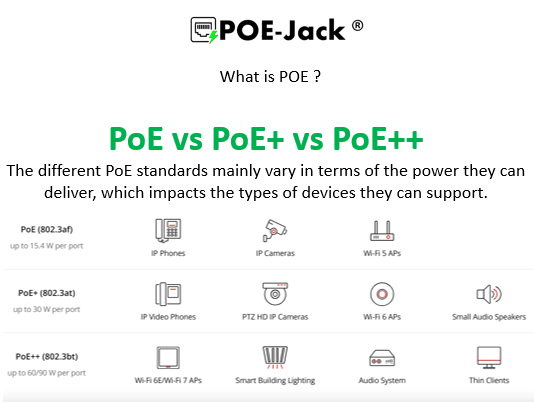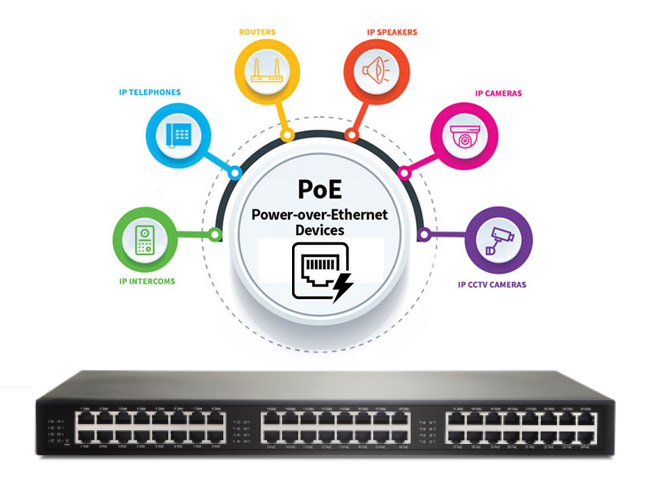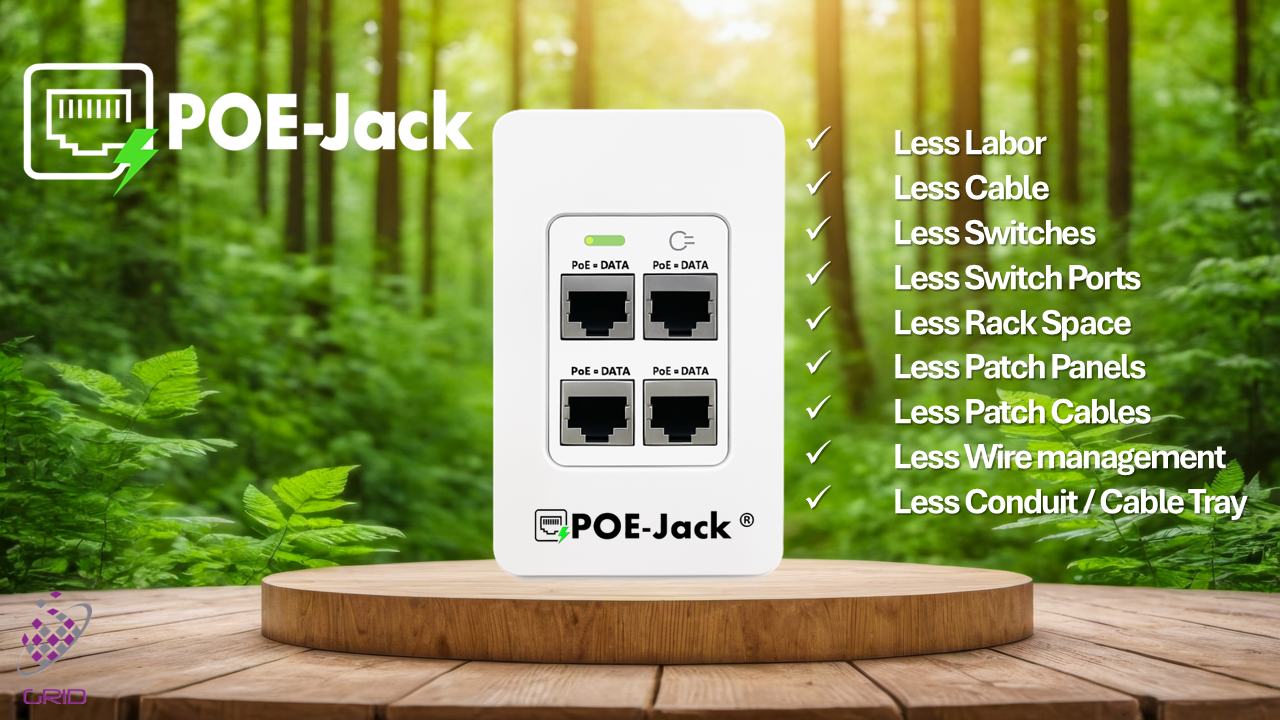POE
Explore our innovative connectivity, transmission, and wire management solutions for your business needs.


POE Applications ?
Discover what devices can use POE
POE Terminology
Optimize your POE and data transmission with our advanced transmission solutions tailored for your business.
What is POE ?
Discover the different POE types
What is POE?
Explore our innovative wire management and transmission solutions today.


POE vs POE+ vs POE++
What is Power Over Ethernet
Power over Ethernet (PoE) is a technology that allows electrical power and data to be transmitted over 100 meters of a single Ethernet cable. This simplifies the installation of network devices, such as IP cameras, wireless access points, POS terminals, kiosks, and VoIP phones, by eliminating the need for separate power supplies. PoE is governed by the IEEE802.3xx standard that defines the methods and specifications for delivering power and data safely and efficiently over Ethernet cables.
Overview of PoE Standards
PoE standards are a set of protocols defined by the Institute of Electrical and Electronics Engineers (IEEE) that promotes the development and application of electrotechnology. Regarding PoE, there are three standards; IEEE802.3af, IEEE802.3at, and IEEE802.3bt, which specify power levels, wiring configurations, and other technical parameters to ensure the safe and efficient delivery of power over Ethernet cables. Adherence to PoE standards guarantees compatibility and reliability across different network devices and manufacturers, promoting widespread adoption and interoperability.
IEEE 802.3af (PoE)
The PoE standards began in 2003 with the introduction of IEEE802.3af standard, also known as the PoE standard, specifies how to safely deliver 15.4W of power from Power Sourcing Equipment (PSE) and 12.95 watts of power at the Powered Device (PD) using 44-57 volts of DC power over Cat5 ethernet cables. The first application was VoIP (Voice Over IP), with other applications, such as WAP (Wireless Access Points), and low-power surveillance cameras quickly adopting the standard, which ensures interoperability between different vendors’ equipment, providing a reliable and widely adopted method for powering network devices.
IEEE 802.3at (PoE+)
In 2009, the IEEE802.3at standard, also known as PoE+, was released. This standard, providing up to 30 watts from the PSE and 25.5 watts at the PD over Cat5 cables. This higher power level supports more demanding devices like PTZ cameras, higher speed wireless access points and video IP phones. It ensures backward compatibility with POE.
IEEE802.3bt (PoE++) Type 3
To meet the growing demand for higher power devices, the IEEE 802.3bt standard was introduced in 2018. Also known as Hi Power PoE (Hi-PoE) and PoE++, the IEEE 802.3bt standard is the latest PoE standard delivering from 60 watts (TYPE 3) to 90 watts (TYPE 4) of power from a PSE. The IEEE802.3bt standard is backwards compatible to the IEEE802,3af and IEEE802.3at standards and can support PD’s with power requirements from 51 watts (TYPE 3) to 71.3 watts (TYPE 4). This standard supports high-power devices such as digital signage, LED lighting, and high-performance wireless access points. IEEE 802.3bt provides greater flexibility and scalability for modern networks, accommodating the growing demand for power-intensive applications.
IEEE802.3bt (PoE++) Type 4
TYPE 4 POE++ ALSO KNOWN AS UPOE (UNIVERSAL POWER OVER ETHERNET), TYPE 4 POE++ DELIVERS UP TO 100W PER PORT. THIS IS ALMOST SEVEN TIMES THE POWER PROVIDED BY THE ORIGINAL TYPE 1 POE STANDARD. TYPE 4 POE++ SUPPORTS DEMANDING DEVICES LIKE HIGH-PERFORMANCE SERVERS AND SPECIALIZED INDUSTRIAL EQUIPMENT.


POE Applications & Devices
Voice and Communication
VoIP phones and video conferencing systems are powered and connected via PoE, enhancing office communication. Conference phones and PBX systems also benefit, ensuring clear and reliable communication solutions.
Datacom / Networking
Wireless networks benefit from PoE, with devices like Wireless Access Points (WAPs) providing both data connectivity and power. PoE supports mesh networking devices, extending coverage, and bridges that connect distant segments without additional power sources. WiFi networks, integral to both residential and commercial environments, rely on PoE to power various networking components, ensuring seamless and reliable wireless connectivity. Additionally, 5G technology, which promises faster speeds, lower latency, and higher capacity, can utilize PoE to power small cell installations, enhancing network performance and coverage.
Data Centers
PoE midspans can power non-PoE network infrastructures for networking equipment, servers, and other devices.
Security / Surveillance
PoE technology is integral to security systems, powering IP cameras for surveillance, access control systems (including biometric fingerprint, facial recognition devices, card readers, electronic locks, keypads, etc.), electronic gate locks and intercom systems for seamless communication in buildings.
Retail (Kiosks, Displays, POS Systems)
Self-checkout and point-of-sale (POS) machines in grocery and retail stores, price-checking kiosks, digital advertising, informational displays, ticket machines, printers, patient check-in kiosks in hospitals, can utilize PoE technology.
Lighting
PoE lighting offers significant advantages in industrial environments. By using Ethernet cables to deliver both power and data to LED lighting fixtures, facilities can achieve greater energy efficiency and simplified installation. PoE lighting systems can be integrated with sensors and building management systems, enabling smart lighting controls such as occupancy sensing, daylight harvesting, and remote management. This integration results in reduced energy consumption, lower maintenance costs, and enhanced operational flexibility.
Building Automation
In building automation, PoE powered LED lighting in offices, retail spaces, and warehouses offer energy efficiency and control advantages. Sensor control systems monitor temperature and humidity. Building automation systems communicate with HVAC systems, incorporating features like occupancy sensors and smart thermostats.
Robotics
In robotics, PoE technology powers robotic arms and manipulators for industrial tasks, supports automated guided vehicles (AGVs) in logistics operations, and enables drones and UAVs for surveillance and aerial missions.
Infrastructure & Public Utilities
Outdoor PoE
Outdoor PoE applications are critical in infrastructure and public utilities. These include powering outdoor security cameras, environmental monitoring systems, traffic management systems, and public WiFi hotspots. PoE can also support street lighting and smart city applications, where sensors and communication devices are integrated into municipal services. Using PoE for these applications simplifies installation and maintenance, ensures reliable power delivery in various weather conditions, and enhances the scalability of urban infrastructure projects.
Public Transit
Transportation Mode
GRID Power-over-Ethernet DC input injectors provide a flexible power delivery option for PoE-enabled devices that operate on DC power sources. These injectors enable the transmission of power and data over ethernet cables, facilitating the use of IP security cameras in environments where DC power infrastructure is prevalent. Users can link them to a battery source. Phihong PoE DC input injectors support data speeds of up to 2.5G and are available in 30W and 90W variants. Common applications include trains, locomotives, and transit surveillance systems.
Medical
Hospitals & Care Facilities
Power over Ethernet (PoE) technology is increasingly being applied in the medical industry to enhance efficiency and functionality in various healthcare environments. PoE lighting systems provide reliable and energy-efficient illumination in hospitals and clinics, allowing for centralized control and integration with other smart building systems. In greenfield applications, where new healthcare facilities are being built, PoE infrastructure offers a flexible and scalable solution for deploying advanced medical equipment and devices. Additionally, PoE supports robust Wi-Fi networks essential for seamless communication, telemedicine, and real-time patient monitoring, ensuring that medical staff have access to critical information whenever needed.
PoE Applications: Wattage and Voltage Range Overview
This should be the most obvious feature of all, there are different wattages and voltages for different types of applications. GRID carries a wide range of products varying power outputs. Wattage ranges from 13W – 576W, and output voltage can range from 5V-56V.
Low power PoE Injector Applications (13W – 30W):
IP Cameras: A low power injector is commonly used to power Internet Protocol (IP) cameras and other surveillance systems like Network Video Recorders (NVRs).
Access Control Systems: PoE injectors can power access control devices such as card readers, keypads, door controllers, biometric fingerprint and facial recognition devices.
VoIP Phones: Voice over Internet Protocol (VoIP) phones and intercoms often utilize injectors to power individual phones in offices or call centers.
Point-of-Sale (POS) Systems: PoE injectors can power devices such as barcode scanners or card readers in retail environments.
APs / Wireless Access Points / Wireless Bridges: A low power injector would be great for powering a wireless bridge. It’s a networking device that connects two or more separate wired networks or network segments.
Digital Signage: Using IP to control the signage and POE to power the signage screens
Monitors: There are desktop monitors that are POE
Docking Stations: Connection hubs for LapTop computers are available in IP/POE
LapTops: LapTops are available that can be powered / charged by POE++
Audio: There are IP / POE speakers for audio, paging and more
Lighting: Commercial, Industrial and residential lighting fixtures are now available as IP/POE
Smart Home Automation: Components like LED lighting, thermostats, and voice assistants can utilize PoE for simplified installation and management
IoT Devices: A wide range of Internet of Things devices, including doorbells, smart home hubs, and sensors, can be powered by PoE.
Industrial controls: A wide range of industrial control devices are now IP / POE for controlling automation and industrial controls
Enabling communication between devices on each network as if they were directly connected by a physical cable, even if they’re located far apart and cannot be connected by traditional means.


In the realm of Power over Ethernet (PoE) technology, several key terms are crucial. This section explores various types of terminology, helping you understand how PoE functions and interacts within network environments.
PSE
Power Sourcing Equipment (PSE) refers to devices that provide power to PoE-enabled devices over Ethernet cables. PSEs can be network switches or PoE midspan/injectors. These devices are responsible for detecting PoE-compatible devices and supplying the appropriate amount of power. PSE plays a critical role in PoE networks, ensuring reliable power delivery and enabling the use of various PoE devices.
PoE Injector and Midspans
PoE injectors and PoE midspans are two terms for the same thing, whether they are 1 port or multi ports. PoE injectors/midspans essentially serve the fundamental purpose of enabling non-PoE network switches to deliver power alongside data to a PoE-compatible device through a single Ethernet cable.
Passive and Active Injectors (Dumb and Smart Injectors)
Passive and Active Injectors are also referred to as Dumb and Smart Injectors: PoE injectors are available in either “passive” or “active” format. Passive PoE injectors provide a fixed output voltage that does not have any negotiation or handshake with the end powered device (PD). Passive Injectors have a simpler design with a lower cost, and are often used in applications where the passive PoE injector and PD are provided together as a bundled solution.
In contrast, active PoE injectors adhere to IEEE standards (such as 802.3af, 802.3at, and 802.3bt) and require a handshake between the active PoE injector and the PD to negotiate and deliver the correct amount of power. The handshake between the active PoE injector and PD is crucial to ensure powering compatibility to avoid damage to the PD. This ensures safety, compatibility, and adaptability to a variety of devices, making active PoE Injectors the perfect solution for open architecture systems requiring the interoperability between injector and PD’s from different manufacturers.
Detection
Detection in Power over Ethernet (PoE) refers to the process by which Power Sourcing Equipment (PSE) identifies whether a connected device is PoE-compatible and capable of receiving power. This detection mechanism is essential to prevent accidental damage to non-PoE devices and ensures efficient power delivery to PoE-enabled devices. Typically, detection involves the PSE sending a low voltage signal down the Ethernet cable to check for the presence of a valid PoE signature. If the connected device responds appropriately, indicating it can accept PoE, the PSE then proceeds to deliver power at the appropriate voltage and current levels. This detection process is standardized across different PoE implementations (such as IEEE 802.3af, 802.3at, and 802.3bt), ensuring compatibility and safe operation within PoE networks.
Classification
Classification in Power over Ethernet (PoE) refers to the process by which Powered Devices (PDs) are categorized based on their power requirements. This classification helps Power Sourcing Equipment (PSE) determine how much power to deliver. PDs can be classified into different classes (such as Class 0 to Class 4), each corresponding to specific power needs defined by IEEE standards (802.3af, 802.3at, 802.3bt). Higher classes require more power, accommodating devices with greater power demands like PTZ cameras with heaters or wireless access points. Understanding classification is crucial for ensuring proper power allocation in PoE networks and avoiding overloading or underpowering devices, thereby optimizing network performance and reliability.
Disconnect
In Power over Ethernet (PoE) terminology, “disconnect” refers to the mechanism that ensures safe power delivery in case of faults or when devices are unplugged. This feature is crucial for protecting both the equipment and the network from potential damage due to unexpected power surges or short circuits. After power is applied to a PD the load is constantly monitored to ensure that it stays within specified envelopes of current, voltage and time. When a disconnect event occurs, the PSE detects an out of envelope level and ceases power delivery to the affected port or device, preventing any potential harm. Understanding disconnect mechanisms is essential for maintaining the reliability and safety of PoE networks, ensuring uninterrupted operation and protection against electrical hazards.
PD
In Power over Ethernet (PoE) terminology, “PD” stands for Powered Device. PDs are devices that receive power and data through Ethernet cables from Power Sourcing Equipment (PSE) such as PoE switches or injectors. These devices include IP cameras, wireless access points, VoIP phones, and other network devices designed to operate with PoE technology. PDs are classified into different categories (Class 0 to Class 4) based on their power consumption needs, allowing PSEs to deliver the appropriate amount of power efficiently. Understanding PDs is essential for designing, deploying, and managing PoE networks effectively, ensuring seamless integration and reliable operation of powered devices.
POE Switch
A Power over Ethernet (PoE) switch is a network switch that, in addition to providing data connectivity, also delivers electrical power over the same Ethernet cables to connected devices. This eliminates the need for separate power outlets and cables for those devices. A PoE switch combines the functionality of a standard network switch with the ability to supply power, usually DC, to devices like VoIP phones, security cameras, and wireless access points. Instead of needing a separate power supply and Ethernet cable for each device, a PoE switch delivers both power and data through a single Ethernet cable
POE Terminology
Solutions
Innovative connectivity and wire management solutions provider.
Connect
Manage
info@poejack.com
702-505-7824
© 2025. All rights reserved.
Write your text here...
LEED and Network Cabling
LEED (Leadership in Energy and Environmental Design) is the world's most widely used green building rating system, providing a framework for healthy, efficient, and cost-saving sustainable buildings. Developed by the U.S. Green Building Council (USGBC).
In the evolving landscape of sustainable design, LEED certification has emerged as a benchmark for green building practices. The latest iteration, LEED v4, introduces a more rigorous approach to sustainability, emphasizing not only energy efficiency but also innovative materials and technologies. For electrical engineers involved in the design and implementation of network cabling in new buildings, understanding the components of LEED v4 and their implications is crucial.
LEED is a certification program established by the U.S. Green Building Council (USGBC) to encourage sustainable building practices. LEED v4, launched in 2013, is a comprehensive update that places greater emphasis on human health, resilience, and performance. It spans several categories: Location and Transportation, Sustainable Sites, Water Efficiency, Energy and Atmosphere, Materials and Resources, Indoor Environmental Quality, and Innovation. Each category comprises various credits that projects can earn to achieve different levels of certification—Certified, Silver, Gold, or Platinum.
For project credits for accreditation related to materials, LEED often specifies that the included products typically fall within CSI MasterFormat Divisions 3 through 10, 31, and 32. These divisions cover elements like concrete, masonry, metals, wood, finishes, and exterior/interior site work. Other divisions, like 22 (Mechanical), 23 (Plumbing) 26 (Electrical) 27 (Communications) and 28 (Electronic Safety and Security Systems) , are generally not included. Products considered "special equipment," such as elevators, escalators, process equipment, and fire suppression systems, are also typically excluded from credit calculations.
LEED V4 offers some changes, while Division 27 itself isn't a LEED credit, its products and systems can be used to contribute to Materials and Resources (MR) category credits, such as those requiring Environmental Product Declarations (EPDs) or contributing to the valuation of installed products. Specifically, passive components from Division 27, like conduits, can be included in cost-based credits or product-based credits, requiring their consistent reporting and consistent inclusion if a project chooses to include elements from this division.
In LEED V4 specifically, passive elements of Division 27, such as the cabling, conduit, and other non-powered physical components, can now be considered for credit. Here are some ways electrical engineers can contribute to LEED certification through thoughtful cabling specifications and installations:
1. Materials and Resources: Networking cables and other infrastructure components should adhere to sustainable sourcing and manufacturing practices. Engineers should look for cables that are made from recycled materials or those that have minimal environmental impact during production. Products with Environmental Product Declarations (EPDs) can contribute points toward LEED certification, as they provide transparent information about the environmental impacts of materials. Having solutions that use less packaging & less product required can be used for credits here.
2. Indoor Environmental Quality: The choices made in network cabling can significantly affect indoor air quality. Selecting products that are free from harmful chemicals, such as halogens or formaldehyde, is paramount. Engineers should prioritize low-emission cables and ensure proper installation to avoid issues that could compromise air quality. Certifications like UL Greenguard can also support compliance with LEED credits. LSZH (Low Smoke Zero Halogen) cables is not a National Electrical Code (NEC) or Canadian Electrical Code (CEC) rating or requirement but rather a descriptor of cable jacket composition and insulator chemical makeup. The "Zero Halogen" means it lacks halogens like chlorine or bromine, which release toxic, corrosive gases when burned. These LSZH cables are a type of insulated cable designed to release minimal smoke and no toxic halogen gases when exposed to fire, providing a safer alternative to traditional PVC-jacketed cables, especially in occupied or poorly ventilated areas like hospitals, schools, and public buildings. The cable's jacket is made from materials that undergo an endothermic (heat-absorbing) chemical reaction in a fire, releasing steam to cool the material and form a char layer, which limits flame spread and toxic gas emission. These LSZH cables are often not used due to high cost, but with cost savings of solutions like POE-Jack® it offers an opportunity to change this for LEED credits and better life safety while still providing cost savings.
3. Energy Efficiency: One of the most significant contributions network cabling can make towards LEED v4 is in designing energy-efficient systems. Utilizing Ethernet cabling that supports Power over Ethernet (PoE) can reduce the need for separate power outlets, thereby leading to lower energy consumption. Additionally, implementing advanced cabling management systems can improve HVAC efficiency, as optimal networking layouts may enhance airflow and thermal management.
4. Innovation: Network infrastructure is critical for smart building technologies. Electrical engineers can integrate Internet of Things (IoT) devices that monitor energy usage, indoor climates, and occupancy rates, contributing to building performance optimization. Innovations that enhance building efficiency can provide additional credits in the Innovation category of LEED v4.
5. Sustainable Practices: Employing sustainable installation practices, such as recycling old cabling or using environmentally friendly installation materials, not only contributes to the overall sustainability of the project but may also align with LEED prerequisites.
LEED v4 presents an opportunity for electrical engineers to play a pivotal role in sustainable building practices through thoughtful network cabling design and implementation. By focusing on material selection, energy efficiency, and innovative integration, engineers can aid in achieving LEED certification while fostering an environmentally responsible future. Understanding and applying these principles is not just beneficial for project success; it is essential in the pursuit of a greener, more sustainable built environment.
New solutions offered by GRID Networking and the POE-Jack® offers some great environmental benefits from saving up to 75% less cabling required, 75% less patch cables, 75% less patch panels, 75% less switch ports, less cable management, less racks, less conduit and less packaging for all the items.
POE-Jack® disrupts the structured cabling industry that has been long stagnant without innovation in the copper premise cabling industry. POE-Jack® requires 1 cable, 1 patch panel port and 1 POE switch port all while providing a 4 ports Ethernet Outlet plate. Compared to traditional jack / patch panel products that require a dedicated cable for each port, so 4 cables, 4 patch panel ports and 4 switch ports that is substantially more product required but also a much larger footprint in racks, cabinets and in telecommunication rooms/closets. The environmental benefit to the reduction of these items is tremendous, the amazing part of it is that it saves money too that can help offset those other LEED requirements that often raise the costs of a project.
POE-Jack® functions as a PoE-powered Gigabit switch integrated into the wall outlet plate, and yes a quarter off that bandwidth is way beyond the needs of 99.5% of the market needs in office environments. Compression / Codec of video streaming has kept bandwidth low, some examples being Netflix 4K Ultra HD is less than 25mbps, Zoom HD is 3.8 Mbps and Teams group video calls are under 10 Mbps. So Gigabit (1000mbps) divided by 4 outlets is more than plenty. The Structured cabling industry has been pushing bandwidth cables for future proofing that has not been required in premises due to technology. Cat6 became a standard in 2002, offering Gigabit to the desktop, many different types of construction and gauges of wire have been used for this. POE standards (802.3af/at/bt) have evolved, IEEE 802.3af (ratified in 2003), IEEE 802.3at (PoE+, ratified in 2009), and IEEE 802.3bt (PoE++, ratified in 2018) have given new purpose to cable in the market to power wireless access points, network cameras, digital signage and even monitors. POE-Jack® runs on less than 2.5w and can be used to extend network distances by cascading them for applications of adding network cameras or wireless access points in parkades, warehouses, airports, campuses, up risers of high rises and many more applications.
The gauge of the wire used in Cat6 becomes more important when using for higher wattage requirements. This is why GRID Networking / POE-Jack® standardized on 23awg Cat6e cable, it is a Cat6 cable by all definition but enhanced with 23awg wires allow for less voltage drop and optimal performance when IEEE 802.3bt POE++ 100w from POE Switch to 95w at POE Device.
For applications such as POS – Point of Sale terminals and Digital Signage again this reduces the cabling needed but adapters are also offered for non-POE systems to adapt them to POE-Jack®.
There is a 3600w 48 Port POE-Switch with hot swappable and dual redundant fans / power supplies to power POE-Jack®, Network Cameras, Access Points, POS and Digital Signage systems.
LEED is advancing to provide opportunity for solutions like POE-Jack® and we look forward to more expansion within the master format credits like this provides.
GRID Networking POE-Jack (POE Jack, POE-Jack® , POE-Jack™ ) truly is the most GREEN environmentally friendly network cabling solution.
GRID Networking POE-Jack (POE Jack, POE-Jack® , POE-Jack™ ) campus / enterprise level POEJK-S48-3600 POE switch is one of the most powerful POE switches in the market with a 3600 watt POE budget.
GRID Networking POE-Jack (POE Jack, POE-Jack® , POE-Jack™ ) POEJK6A-VI is one of the highest performance Cat6a Cat6e Cat6 RJ45 MPTL Crimp Ends, with their Staggered Sled insert for keeping conductors separated for lower crosstalk, it has 50 micron gold plated 4 prong contacts for the best performance.


